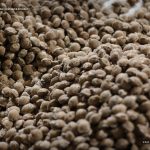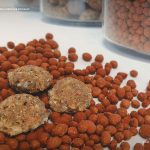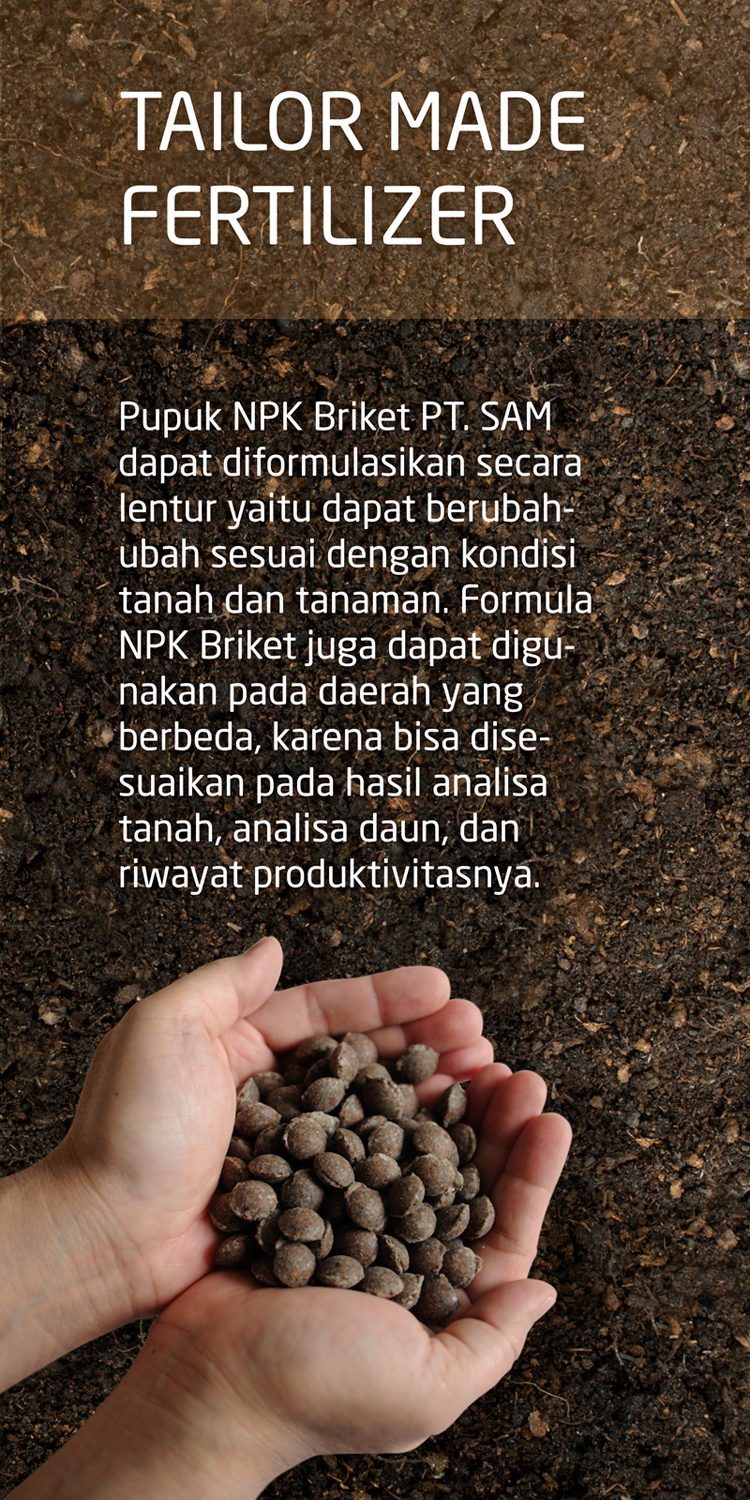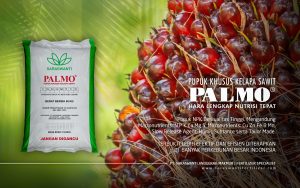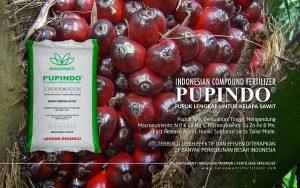Palmo Briquet Fertilizer Usage to Increase Fertilization Efficiency For Palm Plantation In Marginal Land
RINGKASAN
Palmo briquette fertilizer is one of NPK (Nitrogen, Phospat, Kalium) compound fertilizers in a form of briquette ellipse, with diameter of circumference around 1 cm in diameter, and thickness of 0.3-0.4 cm, and weight around 4-5 grams/grain. Palmo briquette fertilizer has been widely applied since the late 90s. Analysis of Palmo briquette fertilizer testing usage in its ability to provide and release nutrients to measure its efficiency carried out through detailed laboratory research scale and field trials within the period of 2012-2015. Through several field trials, Palmo briquette fertilizer usage has been tested in palm oil plantations in marginal land peat soil and coarse texture soil. The testing result indicates that Palmo briquette fertilizer’s ability in releasing nutrients to provide Nitrogen nutrients had recorded consistency measures within 6 months period, while single fertilizer made out of Ammonia Base (Za and urea) was only capable of providing nutrients less than 1 month. The loss of the N & K element is measured relatively higher than the P element. The order of NPK nutrients loss due to percolation tested on mineral soils listed from the smallest order: Palmo briquette < Granul compound fertilizer < single fertilizer. The use of Palmo briquette fertilizer in palm oil plantation indicates higher effectiveness compared to conventional fertilizer, capable of increasing palm plantation yield around 3,2 – 16,8, moreover tested on peat and sand soils may increase fertilization efficiency around 34,8 – 46,1. Palmo briquette fertilizer usage in palm oil plantations has been carried out on a commercial scale in large palm oil plantation companies.
Keywords : Fertilizer, Briquette fertilizer, Palmo, palm, fertilization efficiency, peat soil, sand soil, marginal land.
I. introduction
Research Background
Fertilizer is one of important variables in plantation productivity enhancement. Fertilizer ability is significant to enhance plantation productivity. Many agronomists have reported that fertilizer usage in limited nutrients soil may increase plant biomass productivity up to 100% compared to no fertilizer. Therefore, in agricultural cultivation fertilization has become an important step to do.
The level of fertilization in Indonesia is still relatively lower, estimated around 50-70 compared to countries with advanced agriculture. The main obstacle in such low fertilization efficiency is the marginal environmental conditions and unoptimized application of fertilization and cultivation management. However, several methods to increase fertilization efficiency had been applied, namely by optimizing fertilization guidelines, through proper; type, dosis, method, time, and frequency. In the era of modern agriculture, the knowledge of fertilization based on requirements, including the amount of nutrients element and the type of fertilization used according to environmental conditions in order to achieve maximum fertilization efficiency must be applied.
The use of fertilizer in palm oil plantations had been applied for quite some time. Though the technology of the fertilizer industry had developed more advanced, the use of fertilizer in palm oil plantations in Indonesia recorded a tendency in the usage of single fertilizer and compound NPK fertilizer (past release). Essentially there is nothing wrong in using these types of fertilizer as nutrients will be absorbed immediately by the plantation. However, environmental condition factors are often neglected in fertilizer application as some will be less profitable to several types of fertilizer, for example: in weak nutrients absorbance soil, poor redox potential will hinder availability and nutrients absorbance, the high intensity of water movement percolation and excessive water flow on the soil surface (run off). These marginal environmental characteristics often caused low fertilization efficiency. These factors contribute to the low efficiency fertilization record due which result in unoptimized plantation productivity. Therefore, in several environmental conditions where nutrients absorbance is relatively higher or lower, requires fertilization that is capable of releasing nutrients gradually (in controlled) and slow release.
Palmo briquette fertilizer is one of the slow release fertilizer that provides nutrients for plantation. This fertilizer nutrient release control works physically with relatively larger grains and chemically contained slow release agent (SRA) elements include coloide which is capable of binding nutrients electrostatically. Palmo briquette fertilizer had been widely used in many palm oil plantations both in government and private scale. Information collected from the field trials recorded that the advantages of Palmo application in palm oil plantation are mainly suitable for marginal lands with characteristics of environmental conditions controlled by water flow which may cause high frequent nutrient loss in fertilizer. Palmo fertilizer is suitable to apply in peat soil, tidal soil, sandy soil and sloping soil land.
The large and wide spread of palm oil plantations in Indonesia resulted in heterogeneous land conditions. Half of the palm oil plantation is located in marginal land conditions, such as peat soil and tidal soil. Limited availability of nutrients mainly become the constraints in plant growth in such marginal land. The trial application of maximal fertilization with single fertilizer and Compound NPK fertilizer fast release had been carried out. However, under specific conditions still result in several constraints that require a solution to enhance fertilization efficiency. The use of compound NPK fertilizer slow release is considered to be the best alternative to potentially applied. Several palm oil plantations have reported that the use of Palmo briquette fertilizer slow release increases palm oil production in peat soil and tidal soil.
Goals and Outputs
- provide information of Palmo briquette fertilizer usage for palm oil plantation in its ability to provide NPK nutrients, the loss of nutrients in soils, the enhancement of fertilization efficiency in marginal land with peat soil and sandy soil in palm oil plantation.
- Palmo briquette fertilizer slow release increases palm oil productivity within the category of mature plants and half mature plants in peat soil or tidal soil up to 10 compared to conventional fertilization.
II. The Relations of Peat And Sandy Soil With The Availability Of Nutrients
Peat soil is part of Histosol based on soil taxonomic nomenclature. This soil is composed of plant residues, forming layers of organic materials, which are generally known as thick peat and deep peat. Thick peat consisting of more than 2 meters later contained the minimum supply of elements required by plantation. Meanwhile, in shallow peat it is still possible for the supply of nutrients on the soil surface.
Peat soil based on geomorphology is heavily influenced by water activity. The water surface of peat soil is influenced by high intensity Ground Water Table (GWT) low condition. The waterflow conditions of peat soil are related to nutrient availability of soil which is required by plantation which therefore such situations are unfavorable to the plants need. The plantation nutrients loss of nutrients are a lot significant due to the water flow. Fertilization in such lands by using fast release fertilizer, for example single type fertilizer, during the excessive water flow due to increase in GWT, will result in rapid dissolution of fertilizer which carries seepage horizontal movement towards the drainage ditch. Therefore, often cases in such lands though optimal fertilization had been applied, however nutrients deficiency cases still often resulted.
Sandy soil has a coarse and grainy texture. The dominant mineral soil types that are included in this category are regosol and spodosol soils. General characteristics of this soil are predominantly sand soil texture, low composition of C organic and clay. Sandy soil ability to bind nutrients are relatively low which therefore it has low ability to preserve soil nutrients. The coarse soil texture, high intensity of porosity, low ability to bind nutrients, therefore the loss of nutrients are relatively high. The loss of nutrients usually occurs due to washing. The nutrients that are found on the surface are relatively easy to carry away by the water movement percolation which therefore vanishes from the layer of effective soil. Therefore, generally the sandy soil contains low nutrients and fertilization on the soil surface with the use of past release fertilizer will highly vanish and disappear due to washing, which causes low fertilization efficiency.
In peat soil which environment highly influenced by the water flow on the soil surface and sandy soil which has low ability to bind nutrients requires appropriate nutrient management. Effective fertilization carried out in accordance with water management, as well as fertilizer type selection and proper application frequency management. The use of slow release fertilizer to these types of soil will help to proper nutrients absorbance by the roots because of the minimization of fertilizer nutrients loss.
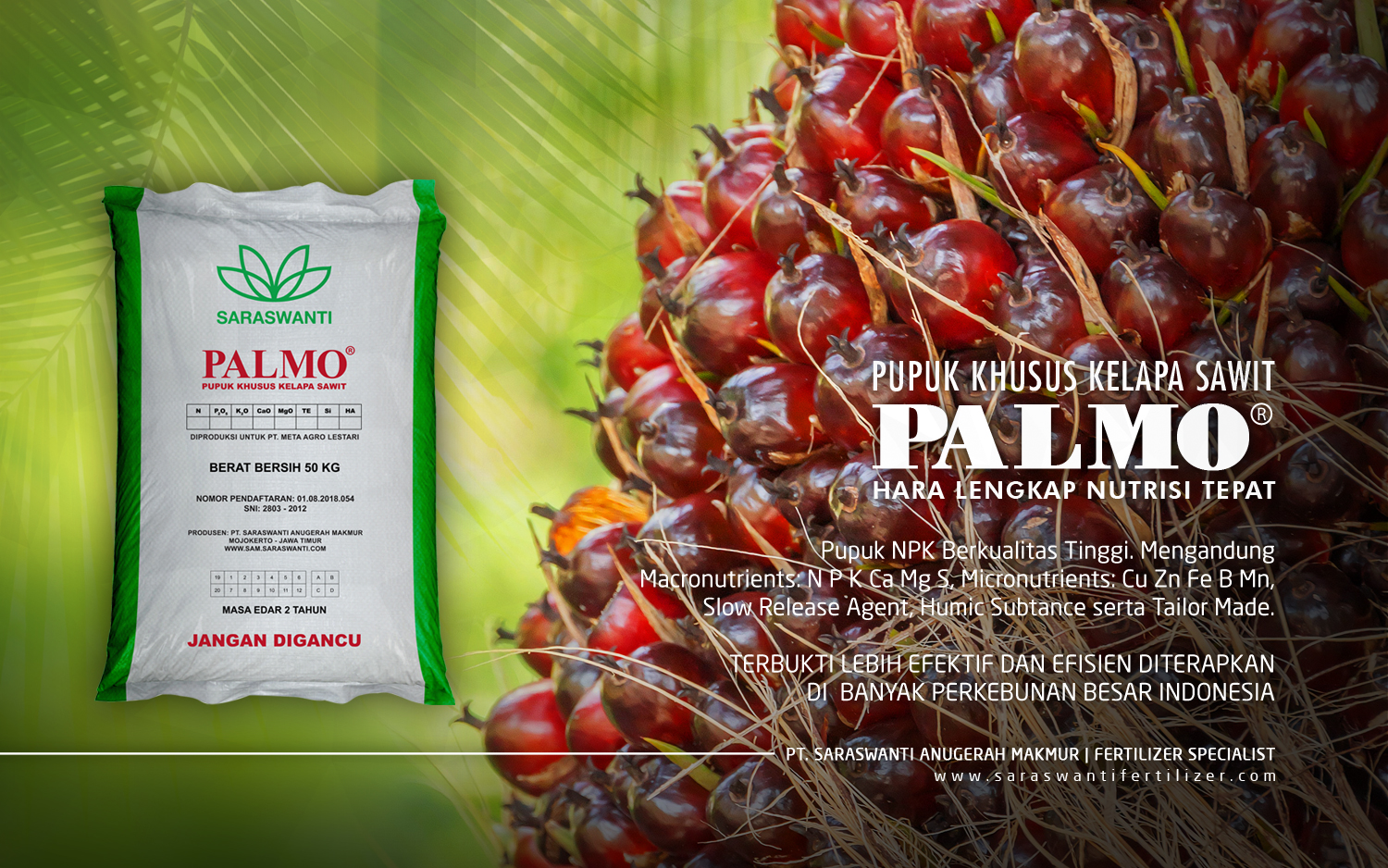
Pupuk NPK Palmo PT Saraswanti Anugerah Makmur
III. PALMO BRIQUETTE FERTILIZER FOR PALM OIL PLANTATION
- Physical And Chemical Characteristics of Briquette Fertilizer
Palmo briquette fertilizer is a solid fertilizer in a form of ellipse-shaped grains measured around 1 cm and thickness 0,4-0,5 cm. This fertilizer weighs around 4-5 grams per grain with density around 1,33-1,75 gram/cm3. compared to conventional fertilizer granular (0,2-0,4 cm diameter), briquette fertilizer contained 4-6 times relatively higher formulation.
Palmo briquette fertilizer consists of several nutrients required by plantation, mainly macronutrients required by plantation which are N (Nitrogen), P (phospat), and K (kalium). Additional nutrients application which commonly less perceived necessary, but significantly contributes to the improvement of plantation production quality, moreover to improve the formulation of fertilizer quality, such as additional macronutrients in complete consist of Cu, Zn, Fe, B, and Si. In order to increase fertilizer quality, fertilizer composition is often modified by enhancing the composition through the addition of materials that can increase soil fertility, such as the addition of humic substance and slow release agent (SRA). Coloide minerals such as the mix of zeolite and bentonite were added in order to enhance the fertilizer’s ability to control nutrients release.
The advantages of physical briquette fertilizer formulated by PT SAM mainly the sizing and massiveness of the fertilizer. The grain sizes are larger which enhance the integration process of all the elements completely which has a slower effect of fertilizer dissolution compared to fertilizers with smaller particles in diameters. The massive characteristic of fertilizers related to the density of micropores on the surface of the fertilizer, modified through the process of compressing resulted in higher density weight (1,33-1,50 g/cm) and helped to slow the dissolution process of hydrolysis. Sizing and massiveness of the fertilizer controlled the slow release agent characteristics. The nutrients released in briquette fertilizer formulated with those two physical characteristics which ensure the nutrients availability based on the pattern of plant growth, especially for annual plantations whose growth period is relatively longer than seasonal plantation.
The formulation of fertilizer in a form of briquette with grain size and massiveness helps to control the nutrients release in check, quite prominently applied to soils with relatively high nutrient washing level, such as coarse texture soil. The increased number of plantation productivity in coarse soil land which fertilization uses briquette formulated fertilizer are relatively higher than finer soils.
- Briquette Fertilizer Mechanism of Control in Nutrients Release.
The dissolution speed is the main target of physical characteristics formula modification. These characteristics are related to the fertilizer ability to provide nutrients for plantation. Plamo briquette fertilizer formulated with technology to control the fertilizer dissolution speed by using physical and chemical mechanisms. Consistently, this fertilizer controls the dissolution of nutrients by providing nutrients with a slow release agent according to the growth pattern of the plants. This type of fertilizer is suitable for plantation crops which have a relatively long growth cycle.
The dissolution and release of nutrients of Palmo briquette fertilizer are slow releases which are modified by using chemical technology through the addition of additive SRA and physics technology with the control of sizing (grain size) and massiveness. Both mechanisms work synergically.
Palmo briquette fertilizer had the ability to dissolve and provide nutrients at a balanced rate. To provide nutrients below the soil surface, start with the process of the fertilizer materials contacting the water from soil moisture. Chemical hydrolysis reaction on the surface of fertilizer will cause the ionization of each material element. This chemical reaction will cause the dissolution of fertilizer material into nutrients in a form of ion fractions. The dissolution of Palmo briquette fertilizer releases micronutrients into the soils which are immediately absorbed by the plants. (See the 2nd picture)
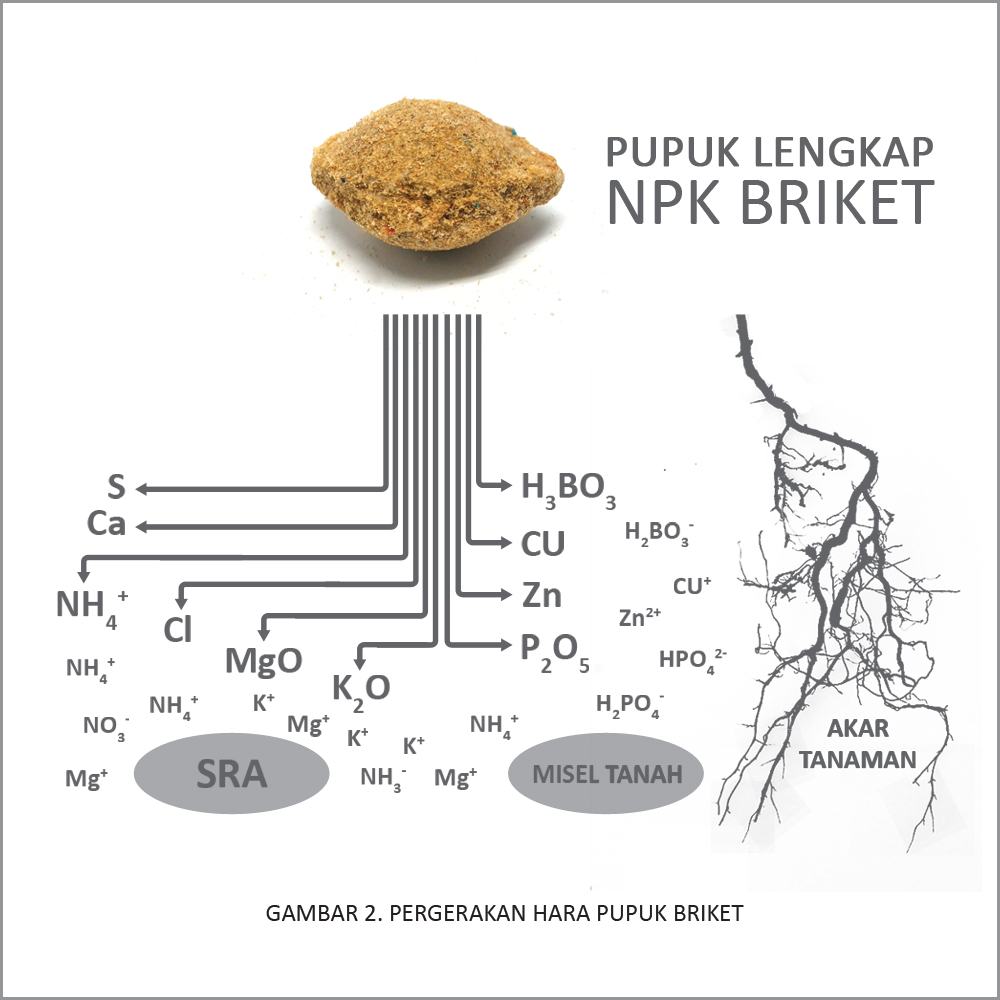
Gambar 2. Pelepasan hara yang terkandung dalam slow release briket Palmo ke lararutan tanah
IV. THE RESULT OF PALMO BRIQUETTE FERTILIZER EFFICIENCY TESTING.
The application of Palmo briquette fertilize to plantation had been carried out through a series of in depth research, including; laboratorium testing and field trials. The summary of testing result provided for Palmo briquette fertilizer application in palm oil plantation, in following:
- Laboratory Research Trials
Testing of nutrients release of Palmo briquette fertilizer on soils had been carried out by using lysimeter soil media simulation. Two different research activities conducted in different years showed the result that nutrients released from Palmo briquette fertilizer are quite consistent (see 2nd picture).
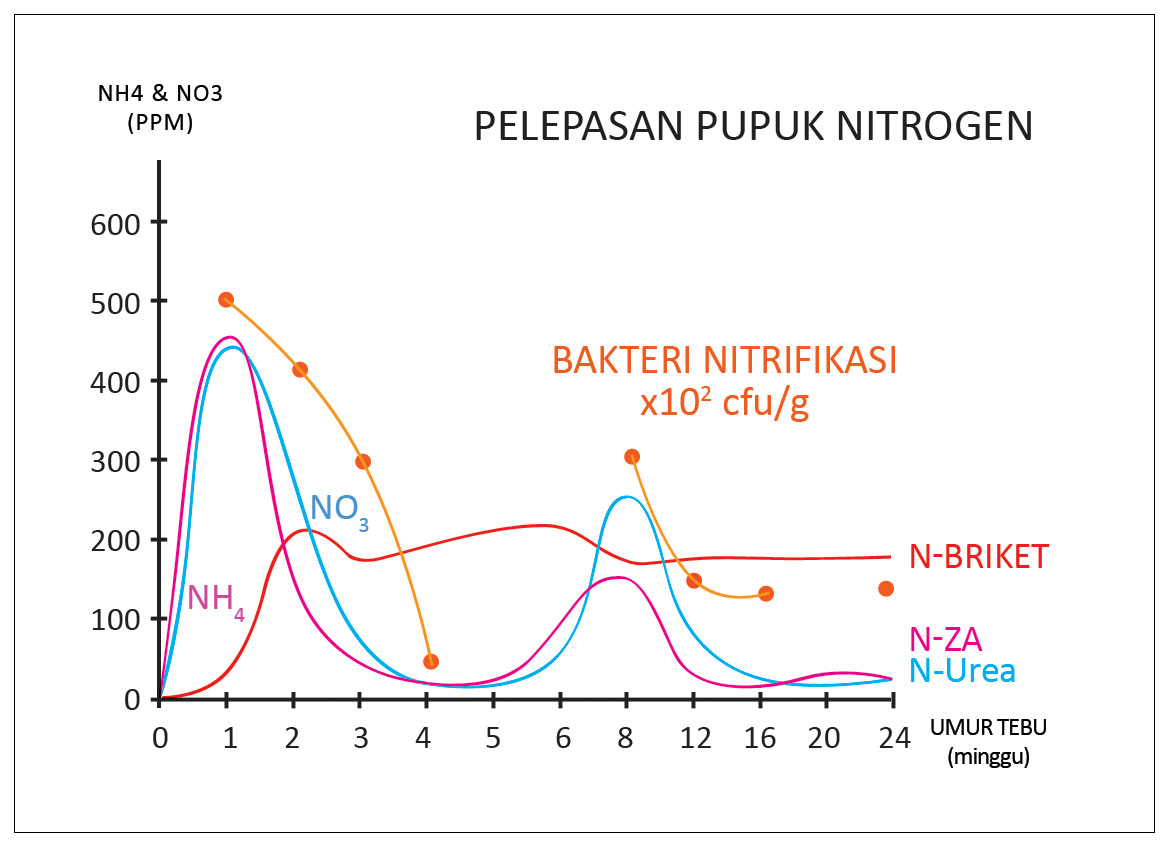
Gambar 1. Pelepasan hara N dari pupuk briket yang diperkaya Slow Release Agent (SRA)
Palmo briquette fertilizers are capable of providing the N (nitrogen) nutrients of soils from the first week of application and optimal availability up to the second week and consistently releasing nutrients up to the 24th week after application. Compared to conventional fertilizer with Ammonia-base (Za and Urea) which releases N nutrients only up to the second week since application, followed by the decrease availability of nutrients which moreover indicated nutrients loss on the 4th week. Therefore Palmo fertilizer is relatively consistent in N nutrients supply up to the 24th week compared to most conventional ammonia-base (Suyanto simon and Edi Premono, 2005).

Gambar 3. Hasil pengukuran kehilangan nutrisi N, P dan K pada pemupukan briket, granul dan pupuk tunggal pada tanah mineral menggunakan metode lisimeter.
Palmo briquette fertilizer consistently supplies the NPK nutrients under optimal condition up to 24th week since application. The loss of nutrients in Palmo fertilizer resulting from the percolation process can be monitored up to the 24th week relatively lower than single fertilizer or granular compound fertilizer. The loss of nutrients starts to be visible on the second month observation. The release of N briquette nutrients in the 2nd month is estimated around 50 ppm, while in single fertilizer the loss of Nutrients is up to 120 ppm or around 2,4 times higher than briquette fertilizer. The increased release on N recorded a higher number within the 6th months of observation, briquette fertilizer release of N up to 150 ppm, while granular compound fertilizers and single fertilizer loses N nutrients up to 240 ppm and 270 ppm. The same pattern of nutrient loss also applied to the K nutrients in fertilizer. On the 6th month observation, the loss of K on briquette fertilizer, compound fertilizer and single fertilizer in order around 80 ppm, 110 ppm, 220 ppm. On the contrary, the loss of briquette fertilizer P nutrients as well as single fertilizer and compound fertilizer are relatively smaller than the loss of N and K nutrients. The N and K soil nutrients embodied movable characteristics on the soil, while the P nutrients are immovable. Generally, the order of NPK nutrients loss caused by percolation which is tested on mineral soil from the smallest are: slow release Palmo < granule compound fertilizer < single fertilizer.
- Palmo Briquette Fertilizer Field Trial Testing
Palmo briquette fertilizer field trial testing had been conducted through a series of demonstration trials with a minimum scale of area 5 ha. The selected land is marginal land with peat soil and sandy soil in palm oil plantations. The trials were conducted within the period of 2012-2015.
- Testing on Peat Soils
Peat soil consists of the accumulation of organic materials resulting from a slow degradation process. The process is caused by reducing the condition of water puddles which disrupts the process of breaking down organic materials. Palm oil cultivation in peat soil may have several challenges, one of them being the supply of nutrients for the plantation. To provide nutrients supply for the plantation, suitable fertilizer technology is required. Slow release fertilizer found to be one of the solutions to provide nutrients supply in peat soil. Testing of slow release Palmo briquette fertilizer had been carried out on several areas.
The result of peat soil testing conducted in Kadeng kecamatan Kotabesi kabupaten kotawaringin plantation, showed that the increased productivity of compound NPK Palmo briquette fertilizer estimated around 39,6 and 37,3 compared to single fertilizer. The observation in Klangsam kecamatan Baning Kabupaten Langsam plantation, the increase in productivity of compound NPK Palmo briquette fertilizer estimated around 34,4 compared to single fertilizer. The similar tendency was also recorded in observations conducted in Tudungsaji Kecamatan Baning Kabupaten langsam plantation, the increase recorded are up to 27,8 compared to single fertilizer.
2nd Tabel. Efficiency testing of single fertilizer and Palmo briquette in several plantation locations in peat soil lands.
| Cultivation Location |
Single Fertilizer (tons/ha/year) |
Palmo Briquette (tons/ha/year) |
Increases |
| Kebun Kanden Kec Kotabesi Kab Kotawaringin Timur | 9.6 | 13.4 | 39.6 |
| Kebun Kanden Kec Kotabesi Kab Kotawaringin Timur | 7.5 | 10.3 | 37.3 |
| Kebun Klangsam Kec Baning Kab Langsam | 6.4 | 8.6 | 34.4 |
| Kebun Tudungsaji Kec Baning Kab Langsam | 7.2 | 9.2 | 27.8 |
| Rerata | 7.7 | 10.4 | 34.8 |
Data Source: data koleksi tim PT Saraswanti Anugerah Makmur
Generally, the increase of productivity usage of compound fertilizer compared to single fertilizer in peat soil around 34,8. Palmo NPK briquette is a compound fertilizer in a form of briquette with slow release characters. These fertilizer characteristics are suitable for peat soil where nutrient loss is often caused by washing. Although the peat cation exchange capacity is relatively higher, however the binding capacity is relatively lower to kation which can be exchanged through a series of fertilization repetition or using available slow release fertilizer. The use of slow release fertilizer such as Palmo briquette fertilizer will be better compared to general NPK fertilizer, which may help to improve efficiency and increase palm oil plantation productivity (Radjagukguk, 1983).
The result of TBM palm oil plantation observation, showed that the use of compound fertilizer generally can help to improve overall growth of the plants indicated by the size of leaf, amount of leaflets, average leaf length, average leaf width, number of leaf midribs and length of fronds. The observation result of NPK Palmo briquette compound fertilizer usage compared to single fertilizer in Klangsam, kecamatan Sintang Kabupaten Sintang Kalimatan Barat plantation will be provided in table 3 as follows.
3rd Tabel. testing of single fertilizer and Palmo briquette fertilizer on peat soil TBM efficiency in Klangsam, Kecamatan Sintang Kabupaten Sintang Kalimantan Barat plantation.
| Treatment |
Leaf Area (m2) |
Number of Leaflets (piece) |
Leaflets Length (cm) |
Leaflets Area (cm) |
Number of Midrib (piece) |
Midrib Length (piece) |
| Palmo 1,5 | 3,5 | 185 | 52 | 3,2 | 33,6 | 216 |
| Palmo 2 | 3 | 172 | 50 | 3,1 | 31,1 | 203 |
| Tunggal | 2,6 | 167 | 48 | 2,9 | 30,9 | 193 |
Sumber data: data koleksi tim PT Saraswanti Anugerah Makmur
- Testing on sandy soil
Sandy soil characteristics consist of granular structure (unstructured), loose consistency, low water absorbance, fast permeability, fast infiltration, low aggregate stability and relatively high soil temperature on the surface. Chemically, sandy soil had low fertility, low cation exchange capacity and relatively high salinity.
Common problems found in sandy soil are relatively low water absorbance and fertility rate. These factors contribute to the high intensity of nutrients washing during the rainy season or irrigation. Fertilization process formulated with relatively small dose and repetitive will be beneficial applied to this type of soil. Slow release fertilizer is one of the perfectly formulated fertilizer for sandy soil. Research analysis results for the comparison of slow release fertilizer such as NPK Palmo compound fertilizer and single fertilizer will be presented on the table 4 below.
4th Table. Efficiency Testing of single fertilizer compare to Palmo briquette in several area of sandy soil plantation
| Cultivation Location |
Single Fertilizer (ton/ha/year) |
Palmo Briquette (ton/ha/year) |
Increase (%) |
| Kebun Serawak Damai – Kalimantan Timur* | 16.0 | 26.5 | 65.6 |
| Kebun Kintap -Kalimantan Selatan | 16.7 | 21.2 | 26.6 |
| Rerata | 16.4 | 23.8 | 46.1 |
Data Source: data koleksi tim PT Saraswanti Anugerah Makmur
*Timeline series observation.
Palm oil productivity in Serawak Damai Provinsi Kalimantan Timur plantation using single fertilizer are estimated around 16 tons per/ha annually, while using NPK Palmo briquette are estimated around 26,5 tons per/ha annually. The increase in optimization is estimated around 65,6 compared to single fertilizer. Another observation took place in Kintap Provinsi Kalimantan Selatan plantation, the use of single fertilizer is estimated at 16,7 tons per year, while the use of compound NPK Palmo fertilizer increases to 21,2 tons per year. Generally, the increase of palm oil productivity which utilizes compound NPK Palmo fertilizer slow release is estimated at 46,1 compared to single fertilizer. These testing results align with research results conducted by Suharta (2007) which stated that the use of slow release fertilizer in sandy soil will help to provide nutrients to plantations.
- Palmo briquette application on a scale of commercial use
The use of Palmo briquette fertilizer on a scale of commercial use has been applied widely in larger palm oil companies, since 2003 until now. Based on data collected approximately 153 companies had applied Palmo briquette, and around 30 big companies had regularly used Palmo briquette products such as; PT Bumitama Gunajaya Abadi (BGA), PT Cipta Plantation Group, PT Hasnur, PT Bahruni, PT Semadam, PT Suka Damai, PT Perkebunan Sungai Putih, PT BW Plantation, PT Asam Jawa Group, PT Musi Rawas Group, PT Multi Prima Entakai, PT Sintang Raya, Perkebunan Sembawa, PT Sawitmas Parenggean, PT Mopoli Raya, PT Medco Agro, PT SJI (Meroke Group), PT Nesterwin, PT Monrad Intan, PT Pranasta, PT Sanggan Perkasa, PT Saraswanti Sawit Makmur dan PT Mitra Agro Lestari.
V. Closing
Effective fertilizer selection and management are crucial to achieve optimal palm oil productivity. Fertilizers are selected based on the basis of nutrients required by the plantation and consideration of environmental conditions.
Palmo briquette fertilizer has been a trend in the fertilizer and palm oil plantation industry especially in peat and sandy soil marginal land. These situations are attributed to several factors such as practical use of fertilizer, complete nutrients supply and slow release agent which help to supply nutrients based on physiology requirement of the plantation and minimize nutrients loss on the soil surface, therefore result in higher effectivity and efficiency compared to conventional fertilizer.
Pengembangan teknologi pupuk briket Palmo diarahkan kepada kombinasi formulasi komposisi, ukuran dan bentuk pupuk dan kecepatan pelarutan pupuk. Pemilihan pupuk sesuai kebutuhan diselasarkan dengan tingkat ketersediaan hara untuk tanaman. Pupuk briket Palmo yang bersifat slow release mampu menyediakan nutrisi hingga 3-6 bulan, sedangkan pupuk tunggal dan pupuk majemuk granul yang fast release mampu menyediakan nutrisi hingga 1-2 bulan sedangkan pupuk yang bersifat pelepasan unsur pada pupuk briket Palmo dalam menyediakan nutrisi N berjalan konsisten selama periode 6 bulan dengan laju sekitar 200 ppm/bulan. Laju kehilangan unsur N dan K asal pupuk briket sekitar 80 ppm/bulan, sedangkan unsur P sekitar 0,13 ppm/bulan. Urutan tingkat kehilangan nutrisi NPK akibat perkolasi yang diujikan pada tanah mineral dari urutan terkecil berturut turut : Briket Palmo < pupuk compound granul < pupuk tunggal. Hasil pengujian pupuk briket Palmo pada kelapa sawit menunjukan efektifitas dan efisiensi yang lebih baik dibanding pupuk konvensional, mampu meningkatkan hasil tandan segar sekitar 3,2 – 16,8{63ef19430aed21309430a9d27d483b2d6a0a1b1e2aa9db0ddbd1c3ba59483af5}. Penggunaan pupuk briket Palmo pada tanah gambut dan tanah pasiran mampu meningkatkan efisiensi pemupukan sekitar 34,8 – 46,1. Penggunaan pupuk briket Palmo diperkebunan sawit sudah dilakukan pada skala komersial di perusahaan perkebunan sawit besar.
DAFTAR PUSTAKA
Engelstad, O. P. 1997. Teknplogi dan Penggunaan Pupuk. Terjemahan. Goenadi, D. H., dan Radjagukguk, B. ed 3. Gadjah Mada University Press. Jogjakarta.
Jacob. A. and H. V. Uexkull. 1960. Fertilizer Use:Nutrition and Manuring of Trofical Crops. Translet by C. L. Whittles. Hannover. 593 p.
Saraswanti Anugerah Makmur, 2009. Palmo: Legalitas, Rekomendasi dan Hasil Pengujian. Laporan kegiatan kerjasama antara PT SAM dengan Pusat Penelitian Kelapa Sawit Medan. Sidoardjo.
Saraswanti Anugerah Makmur, 2009. Pukalet: Legalitas, Rekomendasi dan Hasil Pengujian.Laporan kegiatan kerjasama antara PT SAM dengan Pusat Penelitian Karet Sungai Putih. Sidoardjo.
Saraswanti Anugerah Makmur, 2009. Halei: Legalitas, Rekomendasi dan Hasil Pengujian. Laporan kegiatan kerjasama antara PT SAM dengan Pusat Penelitian Perkebunan Gula Indonesia Pasuruan. Sidoardjo.
Saraswanti Anugerah Makmur, 2009. Koka: Legalitas, Rekomendasi dan Hasil Pengujian. Laporan kegiatan kerjasama antara PT SAM dengan Pusat Penelitian Kopi dan Kakao Indonesia Jember. Sidoardjo.
Radjagukguk, B. & Joetono (Eds.). 1983. Prosiding Seminar Alternatif Pelaksanaan Pengapuran Tanah Mineral Masam di Indonesia. Bulletin No. 18. Fakultas Pertanian UGM.
Suharta Nata, 2010. Karakteristik dan Permasalahan Tanah Marginal di Kalimantan 139-146. Jurnal Litbang Pertanian, 29(4), 2010.
PENGGUNAAN PUPUK BRIKET PALMO UNTUK MENINGKATKAN EFISIENSI PEMUPUKAN PADA TANAMAN SAWIT DI TANAH MARGINAL*)
Oleh : Mohamad Mulyadi. Riset Senter PT. Saraswasnti Anugerah Makmur
*) Makalah disajikan pada acara Workshop Teknologi Pemupukan Pada Kelapa Sawit Pada Lahan Marginal, Hotel Aquarius Boutique, Sampit, 12 Desember 2017



